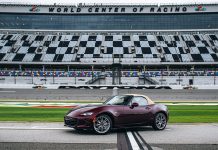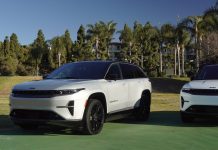This is the first driver assist to allow you to take your eyes off the road.

LOS ANGELES—Mercedes-Benz has never shied away from new technology. Historically, the carmaker has been an early adopter and developer of systems such as antilock brakes, stability control, airbags, and adaptive cruise control. With its EQ line of all-electric vehicles well underway, Mercedes-Benz is now making a push toward automated driving.
We sampled the new Drive Pilot system, which will be available on the 2024 Mercedes-Benz S-Class and EQS sedans, on some of the most congested highways in Los Angeles. It’s the first level 3 automated driving system approved for use in the US, but initially it will only be available and active in California and Nevada. Drive Pilot allows for hands-free highway driving similar to other systems, such as Super Cruise from GM, BlueCruise from Ford, or Highway Assistant from BMW, but goes further by allowing the driver to also take their eyes off the road.
A defined operation design domain
Certain conditions must be satisfied before you can activate Drive Pilot, an important concept in autonomous driving known as the “operational design domain.”
For Drive Pilot to activate, the vehicle must be traveling no faster than 40 mph (65 km/h), it must have a vehicle in front to follow, road conditions must be dry and clear, the lane markings must be detectable, and the route must be pre-mapped by the system. These limitations mean Drive Pilot is for use in heavy stop-and-go traffic, appropriate for the bumper-to-bumper congestion of LA’s I-10 Freeway, but not free-flowing highways. The plan is to increase the speed limiter in the future, though.Advertisement

We started from Santa Monica in unusually light traffic that was flowing well above 40 mph, so we engaged the Mercedes’ hands-on (level 2) adaptive cruise control paired with lane centering as a primer. This allowed us to experience Mercedes’ new Automatic Lane Change feature. As we approached well behind a slower-moving vehicle, the system chimed and displayed a passing maneuver illustration in the instrument panel. A second later, the turn signal activated, and the big sedan smoothly moved into the left lane to pass. This system is available between 40 and 85 mph (136 km/h) and obviously only when the conditions are safe.
No more than a few miles into our drive, traffic began to slow enough for Drive Pilot. Once the speedometer dropped to 40 mph, an illuminated white stripe appeared at the 10 and 2 o’clock positions of the steering wheel’s Drive Pilot buttons, telling us the system was ready. A quick tap of one of those buttons and they turn to green, and you can take your hands off the wheel.
LA traffic becomes a little more bearable
In dense traffic, the system flawlessly maintained a safe following distance and kept the vehicle dead-center in its lane. It slowed to a graceful stop and accelerated just as smoothly. Many vehicles can do this with their own highway driving assist functions, but the difference with Drive Pilot is our ability to look away from the road. You can take in the scenery out the side windows, open a browser in the infotainment screen and do some web surfing, watch a video on YouTube, or play a game with your passenger. Yes, we can also assume some would even feel the urge to be work-productive with this newfound time.
The driver cannot doze off, though, nor can they recline or spend too much time turned around talking to rear-seat passengers. A camera tracks the driver’s eyes and head movement to ensure they will be ready to take over driving duties at a moment’s notice.

As traffic began to flow again, the car we were following accelerated off into the distance and a chime accompanied red Drive Pilot lights on the steering wheel. That’s our notice that we need to get our hands back on the wheel and get back to driving as we exceeded 40 mph to keep up with the traffic flow. The handoff gave us plenty of time to react, and there was no real urgency.
As congestion ebbed and flowed, we experienced this transition in and out of Drive Pilot several times, and each was as easy and smooth as the last. The system will also deactivate when other requisite conditions are not met, as well as when an emergency vehicle is detected, when approaching toll roads, in construction or special regulation zones, or if a pedestrian or cyclist is detected. The system also receives advance warning of hazards from other Drive Pilot-enabled vehicles that may be ahead of you.Advertisement
So how does it all work? In addition to the long-range radar used for adaptive cruise control and stereo cameras mounted atop the windshield for lane identification, Drive Pilot adds lidar scanners in the grille, a more precise GPS antenna at the back of the roof, and several unseen sensors placed all around the vehicle. From an appearance standpoint, the added equipment is subtle. You don’t have a spinning cylinder on top of the car, nor do you have ungainly cutouts or blisters in the body to accommodate sensors.
Mercedes assumes liability
Drive Pilot cannot be retrofitted to existing EQS or S-Class sedans, though. The system must be ordered at the time of purchase, but the cost is a surprise. Rather than charge for all the equipment upfront, Drive Pilot will initially be rolled out as a $2,500 annual subscription.
Confidence in Drive Pilot is high within Mercedes-Benz, as the system has been active in Germany for over a year without incident. That confidence is demonstrated by Mercedes’ decision to assume liability for the vehicle while Drive Pilot is in use. That’s a particularly bold move since no other manufacturer offers that kind of assurance. There are some conditions, of course.

Owners and drivers are required to be familiar with the system, helped by education and familiarization at the dealership or online. To initially activate the system, viewing a seven-minute instructional video is also required. Operators are also responsible for keeping their vehicle in good condition. The sensors must be clean, tires must be in good condition, and the vehicle must also be properly maintained and serviced.
Since Drive Pilot is only currently certified for use in California and Nevada, sales are limited to these states. As more mapping data is gathered, we expect coverage to widen and operating speeds to increase, but there’s no timeline for those. There’s also another feature in development that identifies when Drive Pilot is active, with unique turquoise exterior lighting.
Mercedes-Benz’s bold plan for Drive Pilot is tempered by its sensibly cautious approach. The incremental rollout will build consumer confidence along with its assumption of liability. Despite its conditional limitations, it’s an impressive execution with much future potential.




